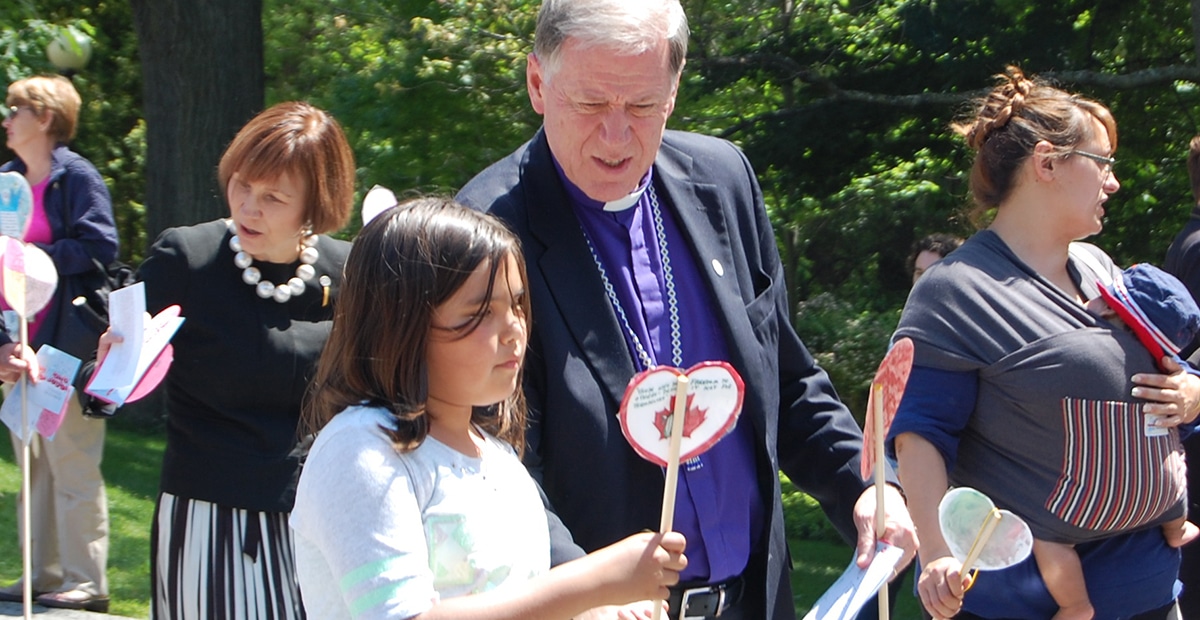Remembering the past while offering hope for the future, the final day of theTruth and Reconciliation Commission (TRC) closing ceremonies on Wednesday, June 3 made it clear that the journey towards reconciliation in Canada has just begun.
The ceremonial end of the four-day TRC national event took place in the Governor General’s residence at Rideau Hall. Indian residential school survivors and their family members assembled alongside representatives of the parties to the residential schools settlement agreement including Archbishop Fred Hiltz, Primate of the Anglican Church of Canada, leaders of other churches, and Prime Minister Stephen Harper.
As noted by Justice Murray Sinclair, TRC commissioner and chair, Rideau Hall symbolized the historic relationship and legal obligations between the Crown and all Indigenous peoples of Canada.
Following an opening prayer by Elder Evelyn Commanda-Dewache, a residential school survivor, Governor General David Johnston offered remarks that highlighted the inportance of the TRC.
“A moment like this arises very rarely in a country’s history,” Johnston said. “This is a moment for national reflection and introspection. This is a moment to reflect on our history, our relationships and our responsibilities towards each other, to think about the depth of our commitment to tolerance, respect and inclusiveness, and whether we can do better in Canada.”
Answering the last question in the affirmative, he noted the generations of First Nations, Métis and Inuit people who suffered as a result of the residential schools.
“For many,” Johnston added, “that pain continues”—a point reinforced by the tearful reactions to a video detailing the experiences of survivors.
Reinforcing the connection between residential schools and the social ills disproportionately faced by Indigenous communities today, Justice Sinclair emphasized that “this history is about so much more than just schools.”
In the course of the TRC hearings, he said, survivors “told us about their healing journeys, often barely begun; their determination to reclaim identity, to rekindle kinship bonds, to relearn endangered languages and land-based skills, and to recommit to traditional spiritual healings and practices.”
The Governor General urged non-Indigenous Canadians to learn more about the cultures of the country’s Aboriginal peoples.
At the end of the ceremony, children led those in attendance outside to witness the planting of a heart garden, which consisted of laminated hearts on stakes with messages honouring the children who attended Indian residential schools.
“This sequence of events,” Johnston said, “reminds us that while the survivors of residential schools brought us to this point, it is their children, along all children in this country, who will lead us in the future towards a new kind of Canada.”
Across the city, a final call to gather outside Ottawa City Hall featured a succession of musical performers—including the legendary singer-songwriter Buffy Sainte-Marie, who is of Cree background and called the end of the TRC closing ceremonies “a day of sadness, but a day of rejoicing” where “ignorance is lifted.”
Where the closing ceremony had seen many tears, the final call to gather was characterized by a sea of smiling faces, with the crowd joining hands together in a massive round dance. The joy of the occasion marked a welcome relief from the heavy emotional toll of the previous days.
Reflecting upon the final day, Public Witness for Social and Ecological Justice Director Henriette Thompson, who co-ordinated Anglican participation in the TRC in the years leading up to the event, called it “a very historic occasion.”
“I think it marked a turning [point] that was felt by people who were involved in the TRC closing ceremonies over the past few days, that there was…something that had changed in…this country’s soul … There was a sense of being together and realizing that the Truth and Reconciliation Commission work had really opened our eyes to things that we had never acknowledged before.”
Noting her plans to improve her own knowledge of the Cree language, Thomson praised the residential school survivors for their reminder that the TRC represented “a matter of the heart,” one that would inform the actions of the Anglican Church moving forward.
“This is about heart work,” she said. “And the heart work is something I think that our church is going to get into more deeply.”
The Anglican Church of Canada will continue to honour the work of the TRC with its #22Days project, which runs until National Aboriginal Day on June 21.
Interested in keeping up-to-date on news, opinion, events and resources from the Anglican Church of Canada? Sign up for our email alerts .

